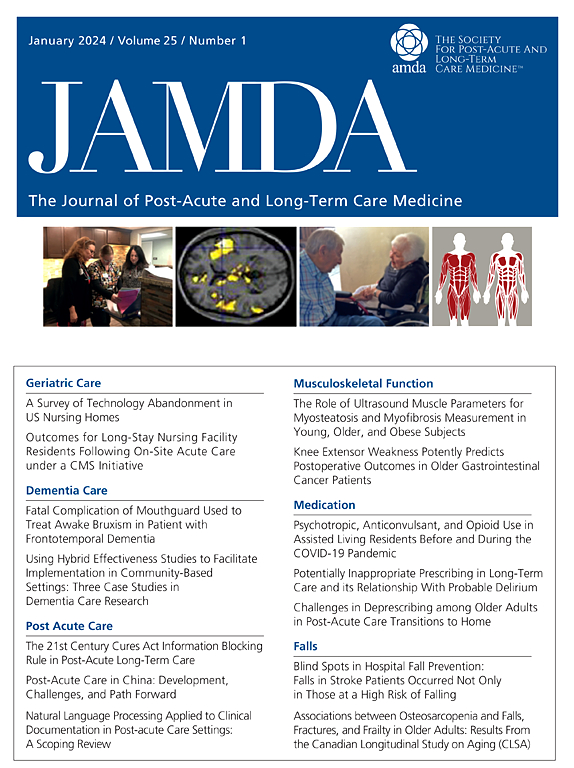Effectiveness of Interventions for Reducing Sedentary Behavior in Older Adults Living in Long-Term Care Facilities: A Systematic Review and Meta-Analysis
IF 4.2
2区 医学
Q2 GERIATRICS & GERONTOLOGY
Journal of the American Medical Directors Association
Pub Date : 2025-06-04
DOI:10.1016/j.jamda.2025.105685
引用次数: 0
Abstract
Objectives
To evaluate the effectiveness of interventions aimed at reducing sedentary behavior (SB) and/or increasing physical activity (PA) among adults aged ≥60 years residing in long-term care facilities (LTCFs).
Design
Systematic review of randomized controlled trials (RCTs) and pre-post interventional studies targeting SB reduction and/or increase in PA, following PRISMA guidelines.
Setting and Participants
Six studies conducted in LTCFs across Europe and North America, involving 403 participants aged ≥60 years.
Methods
We searched 7 databases (Cochrane Library, PubMed, Scopus, PEDro, ScienceDirect, ClinicalTrials.gov, and Google Scholar) up until January 2025 and screened reference lists for additional articles. Two independent reviewers screened titles, abstracts, and full texts, resulting in the inclusion of 6 studies: 3 pre-post interventional studies and 3 RCTs. The primary outcome was time spent in SB, measured via device or self-report, whereas secondary outcomes included quality of life, depression, physical health (physical function, cardiovascular and metabolic health, adverse events), and social isolation.
Results
One RCT found that the intervention reduced SB compared to usual care, whereas the other studies reported nonsignificant improvements. Notably, interventions focused on SB rather than PA showed potential positive effects on reducing sedentary time. However, limitations such as small sample sizes, heterogeneity, and risk of bias were common, highlighting the need for further research.
Conclusions and Implications
In conclusion, this review emphasizes the uncertainty surrounding the effectiveness of SB reduction interventions in LTCFs. Future research should refine methodologies, standardize interventions and outcome measures, and build a stronger evidence base to guide intervention development and improve well-being in LTCF residents. Findings also suggest that SB-focused strategies may be more effective than PA-based ones alone and could inform policy and practice development in LTCFs.
减少长期护理机构中老年人久坐行为干预的有效性:一项系统综述和荟萃分析。
目的:评估旨在减少居住在长期护理机构(ltcf)的≥60岁成年人久坐行为(SB)和/或增加身体活动(PA)的干预措施的有效性。设计:系统回顾随机对照试验(rct)和干预前后研究,目标是SB降低和/或增加PA,遵循PRISMA指南。环境和参与者:在欧洲和北美的ltcf中进行了6项研究,涉及403名年龄≥60岁的参与者。方法:我们检索了截至2025年1月的7个数据库(Cochrane Library、PubMed、Scopus、PEDro、ScienceDirect、ClinicalTrials.gov和谷歌Scholar),并筛选了参考文献列表以获取其他文章。两位独立审稿人筛选了标题、摘要和全文,最终纳入了6项研究:3项介入前研究和3项随机对照试验。主要结局是在SB中度过的时间,通过设备或自我报告来测量,而次要结局包括生活质量、抑郁、身体健康(身体功能、心血管和代谢健康、不良事件)和社会隔离。结果:一项随机对照试验发现,与常规护理相比,干预减少了SB,而其他研究报告无显著改善。值得注意的是,专注于SB而不是PA的干预措施在减少久坐时间方面显示出潜在的积极作用。然而,样本量小、异质性和偏倚风险等局限性是常见的,突出了进一步研究的必要性。结论和意义:总之,这篇综述强调了在ltcf中减少SB干预措施有效性的不确定性。未来的研究应完善方法,规范干预措施和结果测量,并建立更强有力的证据基础,以指导干预措施的制定和改善LTCF居民的幸福感。研究结果还表明,以中小企业为重点的战略可能比单独以pa为基础的战略更有效,并且可以为长期信托基金的政策和实践发展提供信息。
本文章由计算机程序翻译,如有差异,请以英文原文为准。
求助全文
约1分钟内获得全文
求助全文
来源期刊
CiteScore
11.10
自引率
6.60%
发文量
472
审稿时长
44 days
期刊介绍:
JAMDA, the official journal of AMDA - The Society for Post-Acute and Long-Term Care Medicine, is a leading peer-reviewed publication that offers practical information and research geared towards healthcare professionals in the post-acute and long-term care fields. It is also a valuable resource for policy-makers, organizational leaders, educators, and advocates.
The journal provides essential information for various healthcare professionals such as medical directors, attending physicians, nurses, consultant pharmacists, geriatric psychiatrists, nurse practitioners, physician assistants, physical and occupational therapists, social workers, and others involved in providing, overseeing, and promoting quality

 求助内容:
求助内容: 应助结果提醒方式:
应助结果提醒方式:


